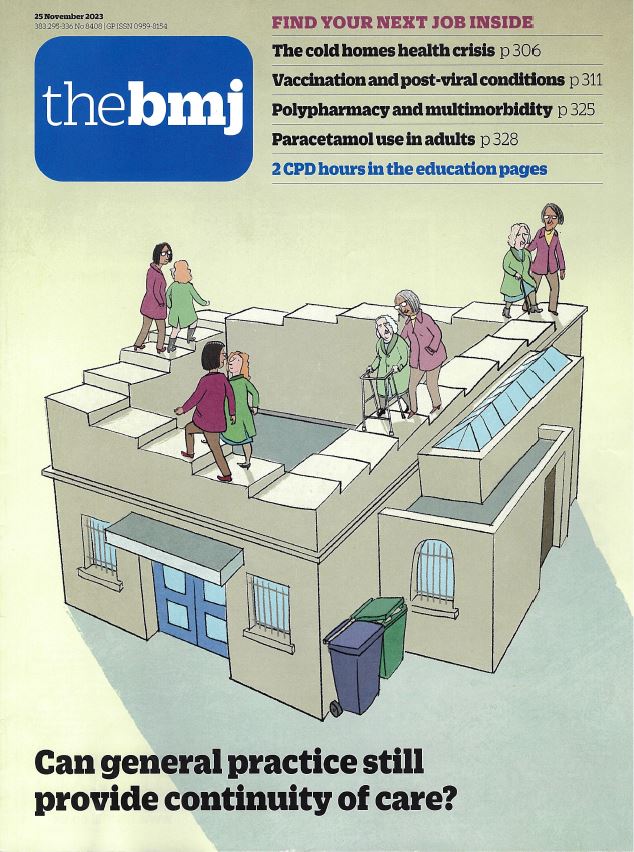Exeter Collaboration for Academic Primary Care (APEx) Blog
Exeter Collaboration for Academic Primary Care (APEx) Blog
Posted by ma403
5 January 2024Prof Philip Evans

January 2024
As most of you will be aware I have been researching GP continuity for many years alongside Sir Denis Pereira Gray and Dr Kate Sidaway Lee in St Leonards Research Practice. It is a few years since my last APEx blog on this (“throwing out the baby with the bathwater”), so it would be good to update colleagues on GP continuity and how our research is impacting on general practice, starting to gain significant attention and stimulate a wider debate.
This renewed interest in continuity was originally triggered by our systematic review published in 2018 which demonstrated that better continuity of care with any form of doctor was associated with a reduction in mortality. This was subsequently confirmed in primary care alone (1). Our BMJ Open paper (2) has been downloaded almost 90,000 times and widely cited. Subsequently we have attempted to explain why continuity could be better for patients in our discussion paper in the BJGP.(3)
The increasing interest in continuity was highlighted by our recent article in the BMJ (4) which will was featured on the front cover. This was written in collaboration with Mark Rickenbach (previously the continuity champion for the RCGP) and Catherine Johns as PPIE adviser to the research practice.
The thrust of our analysis article was that, despite the pressures facing general practice and the prevailing drop-in GP continuity, it is still possible to provide meaningful continuity of care in general practice. The evidence demonstrates that improving continuity of care is associated with better outcomes for patients and for the health service as a whole. For example, our recent paper with Delgado and colleagues from Exeter showed that in high-risk patients with dementia, increased continuity was associated with better prescribing, reduced delirium, incontinence and reduced admissions, amongst other outcomes (5).
One of the major challenges to improving GP continuity is the complexity of measurements that abound. Most are difficult to apply in a service delivery setting and some, such as the Usual Provider of Care Index (UPC), exclude any patients who have not consulted three times or more. Our BJGP paper(6) this year compared the commonly used metrics and suggested either using the UPC or our own St Leonards Index of Continuity of Care (SLICC), which lends itself better to practices with personal lists (7). We have consistently seen the use of personal lists as an evidence-based method of improving continuity.(8)
The challenge therefore is not that further research is needed, although arguably a randomised trial of improving continuity could settle the debate once and for all, but that more attention needs to be paid to implementation of continuity and the barriers and facilitators to making that happen. It is notable that building on the evidence-base and our advocacy for continuity, the Local Medical Committee (LMC) conference recently voted to promote continuity, the Health and Social Care Select Committee also recommended that continuity should be measured and promoted (9), and indeed NHS England have recently announced a consultation on the Quality and Outcomes Framework (QOF), which specifically asks for continuity-related comments.
Clearly this debate will continue but it is good to see that Exeter research (www.continuitycounts.com) is underpinning these policy and contractual discussions.
1. Baker R, Freeman GK, Haggerty JL, Bankart MJ, Nockels KH. Primary medical care continuity and patient mortality: a systematic review. Br J Gen Pract. 2020;70(698):e600-e11.
2. Pereira Gray DJ, Sidaway-Lee K, White E, Thorne A, Evans PH. Continuity of care with doctors-a matter of life and death? A systematic review of continuity of care and mortality. BMJ Open. 2018;8(6):e021161.
3. Sidaway-Lee K, Pereira Gray D, Harding A, Evans P. What mechanisms could link GP relational continuity to patient outcomes? Br J Gen Pract. 2021;71(707):278-81.
4. Pereira Gray D, Sidaway-Lee K, Johns C, Rickenbach M, Evans PH. Can general practice still provide meaningful continuity of care? BMJ. 2023;383:e074584.
5. Delgado J, Evans PH, Periera Gray D, Sidaway-Lee K, Allan L, Clare L, et al. Continuity of GP care for patients with dementia: impact on prescribing and the health of patients. Br J Gen Pract. 2022;72(715):e91-e8.
6. Pereira Gray D, Sidaway-Lee K, Whitaker P, Evans P. Which methods are most practicable for measuring continuity within general practices? Br J Gen Pract. 2023;73(731):279-82.
7. Sidaway-Lee K, Pereira Gray D, Evans P. A method for measuring continuity of care in day-to-day general practice: a quantitative analysis of appointment data. Br J Gen Pract. 2019;69(682):e356-e62.
8. Pereira Gray D, Sidaway-Lee K, Evans P. Continuity of GP care: using personal lists in general practice. Br J Gen Pract. 2022;72(718):208-9.
9. Select Committee for Health and Social Care. Publications on the future of general practice. 2022. https://committees.parliament.uk/work/1624/the-future-of-general-practice/publications/